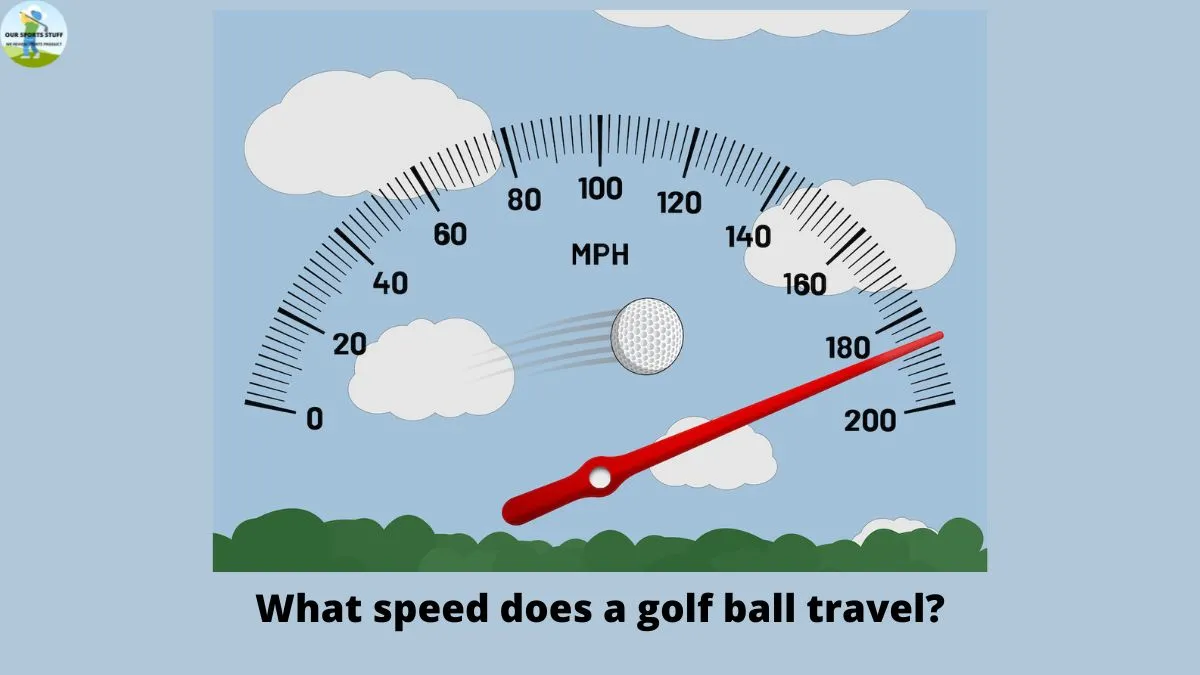What Speed Does a Golf Ball Travel? If you’re a golf enthusiast, questions like these would surely pop up out of nowhere.
Although the fastest ever recorded speed of a golf ball is around 225 mph, there are many other statistics and charts on the speed of golf balls traveling.
In our guide today, we’ll talk about different speed-related factors about approved golf balls. If you’re ready to get an in-depth understanding of these issues, follow the discussion!
- What Speed Does a Golf Ball Travel?
- How Fast Does a Golf Ball Travel?
- How Fast Does a Golf Ball Travel with a Driver?
- Do golf balls fly faster than swing speed?
- How fast does a golf ball accelerate?
- What Should My Golf Ball Speed Be?
- How fast does a golf ball travel with 3 wood?
- How fast does a golf ball travel with 4 iron?
- How fast does a golf ball travel with 7 iron?
- Tips for creating great speed in your golf ball
- Final Thoughts
What Speed Does a Golf Ball Travel?
Golf ball speeds may depend on various factors also, 225 mph is the fastest ever recorded speed actually.
Let’s learn more about it!
How Fast Does a Golf Ball Travel?

The maximum speed a golf ball can travel is around 225 mph which we previously mentioned already.
This test was done in a highly controlled environment and the results were pretty interesting.
The golf ball speed depends on many things. However, you also want to learn the average golf ball speed. In that case, it’s 132.6 mph. The result is an overall assumption and the speed of each strike would determine how fast the ball will go.
How Fast Does a Golf Ball Travel with a Driver?
The speed can vary from 110 to 140 mph while using a driver.
Drivers offer you the maximum hitting possibility. As a result, it will help you hit the longest distance out of it. The golf ball speed is mainly based on how fast your golf swings.
Do golf balls fly faster than swing speed?
Yes, the golf ball will fly faster than the swing speed.
However, the professional’s swing speed will determine how fast the ball will travel. The basic rule of thumb is golf will travel 1.5 times faster than the speed of swing. So, make sure you hit hard if you want the ball to go the extra distance.
How fast does a golf ball accelerate?
Usually, the golf ball acceleration can be around 180-225 mph at maximum.
As said earlier the acceleration of a golf ball mainly depends on the clubhead speed of the swing. However, the speed can be significantly low if the golfer needs to take close shots.
What Should My Golf Ball Speed Be?
Professional golfers can swing the club as fast as 115mph.
The ball speed can reach 170-190 mph based on wind conditions. However,there is no particular golf ball speed limit that you must follow. While golfing, you may need to adjust the clubhead speed to suit different positions and terrains, so it may vary based on various aspects.
If you can hit this fast, congratulations, you do meet the hitting strength of professional golfers!
How fast does a golf ball travel with 3 wood?
The average travel ball speed for 3 wood golf clubs is around 100-150 mph.
If you’re looking for extreme accuracy and the desired backspin, 3 wood would be your quality companion. Workability control is just another feature that is commonly associated with 3 wood. So, if you’re going to use 3 wood, keep that in consideration.
How fast does a golf ball travel with 4 iron?
You may get around 130-150mph if you hit at around 90 mph of clubhead speed with 4 iron.
Similar to the 3 woods, 4 iron too is specifically designed for offering exceptional precision for golfers. The ball speed with 4 iron is different with every hit.
How fast does a golf ball travel with 7 iron?
For the PGA tour, it has been recorded to be around 120 mph, while the speed is 104 mph for LPGA.
So, the total average speed a golf ball travels with 7 iron would be around somewhere between 110-115 mph which is the desired ball speed for many golfers.
Each club has its own strengths and weaknesses; some are designed for covering a large distance, while some are used primarily to get precise shots. In all honesty, 7 iron isn’t completely built for ball speed.
With a 7 iron, you can hit around 135 yards. For women, this is around 75 -80 yards.
Tips for creating great speed in your golf ball
Getting a faster ball speed with your golf club may seem like a challenging job at first. But if you follow certain guidelines and tips, that can become extremely easy. Let’s check out some quality tips to create the desired speed.
Increasing Power through Strength Training
One of the most crucial techniques is to use strength training so that the golf ball leaves at the desired speed. Strength training can build up the required power so you can hit the ball harder and make it achieve enough ball speed.
Many get the idea wrongly and focus on bodybuilding. Well, that may help but with a big chest and biceps, you may not get what you’ve been looking for.
That’s why we’d suggest you focus solely on strength training. Especially target areas like hip, abdomen, and forearm. These are the main areas that will help you strike harder and faster.
We do recommend working out using a medicine ball for the maximum output.
Learn to Swing Correctly for Club Speed
Well, if you don’t have the correct posture and techniques for faster swing speed, the strength would not come in handy and produce varying ball speeds. Each and every golfer needs to move his body in a certain manner to get the right impact.
Most newcomers want to swing the way they feel good without caring much about swing speed. However, most of the time, they may have poor posture, which is not being able to maximize the efficiency of the strength being used and cannot generate the required swing speed.
That’s why you must master the swing speed techniques, so the golf ball travels to the desired location.
Don’t Get Stuck on the Downswing
Getting stuck on the downswing is one of the most common reasons why beginners don’t get to generate enough ball speed.
They produce varying ball speeds without any consistency. There are different ways not to get stuck in the downsizing; here are some mistakes you must have a thorough understanding of.
Standing Too Near to The Ball
It’s a common understanding that standing too close to the ball and golf equipment wouldn’t let you generate enough force. So, we’d suggest you have a slight space between you and the ball, so you get to generate enough ball speed.
Closed Alignment
Closed alignment refers to the misplaced foot positions. It can happen if you place your feet too far ahead while keeping your back foot too far behind.
This results in a poor striking posture, and you end up getting stuck in the downswing. So, we’d recommend you fix the feet’ alignment for a quality club speed that will cover the distance you want.
Keep the Back Foot Flexible
When you put a lot of weight on the backfoot, the ball speed tends to be affected highly, and it also affects ball velocity. That’s why a good trick to reduce downswing is to minimize the weight placed on the back foot and keep it flexible. Your spine will tilt when the weight is placed and may create a downswing. So, be very cautious about this one.
Well, if you’re able to work on the strength training well and learn the club speed swing techniques properly, the possibilities of gaining the desired speed are pretty high.
Moreover, correcting your posture to reduce downswing issues is equally important. Combining these methods, you should be able to maximize speed to a certain degree. This way, you can master the art of reducing downswing, and it would not affect ball velocity much.
Final Thoughts
After a detailed discussion on golf ball speeds and how one can improve the overall performance, we’re at the closing parts. Throughout the guide, we’ve got to learn the different speed outputs for different club types.
Moreover, we’ve also acquired an authentic understanding of how you can improve the golf ball traveling speed to a certain degree.
As we now know what speed a golf ball travels in different contexts and have learned how to adapt the styles accordingly, it’s time to put some real effort into the golf course. Head to a course and show your skills right now!


2 thoughts on “What speed does a golf ball travel?”